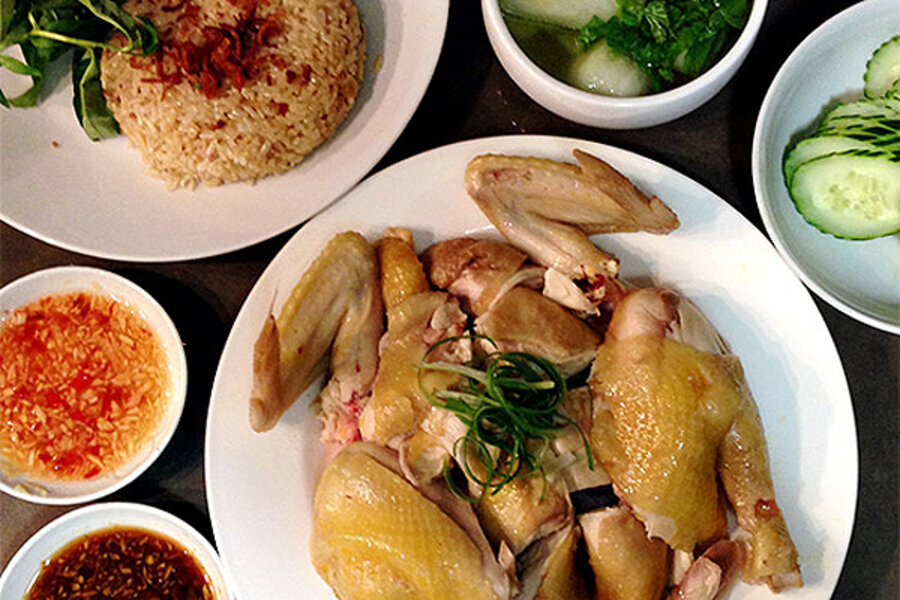Hainan chicken rice
Loading...
For a simple dish, com ga, or chicken rice, is a beloved dish in our family. Although it originated from a small island of Hainan or Hai Nam in the South China Sea between Vietnam and China, it’s popularity can be seen on menus throughout Asia. There are numerous variations (uses of aromatics, spices, dipping sauces) and claims for the best or most “authentic” chicken rice, but frankly, we think this is the one time where the ingredients make the dish.
Since the chicken is the star, you absolutely have to have use the best chicken you can afford. At a minimum, your chicken should be free range. Organic free range would be even better, but that can be tough to find. If you have access to Vietnamese supermarkets, look for gà đi bộ, or Buddhist chickens, with the head and feet still attached. These chicken have less fat and water content then your typical Tyson or Foster Farms chicken and yields much more flavorful, tender, yet deliciously chewy meat. Even the fat on these chickens is prettier shade of yellow and full of flavor and never gets thrown out.
If the chicken is the star, the co-star is the rice. Normally white jasmine rice is used but we prefer brown rice. Whatever rice you use, it’s simply not enough to just cook the rice in chicken broth. You need chicken fat and plenty of aromatics to truly give the rice the depth of flavor it needs.
After poaching the chicken, we use the fattiest portion of the broth and and combined with sauteed garlic, shallots, ginger, and lemongrass. Cook it any way you like, be it stove-top or rice cooker. Then take it a step further and sprinkle crispy shallots over top prior to serving. Finally, with the leftover broth that you haven’t used for the rice, you can create a soup with whatever seasonal vegetable you have on hand. Some restaurants just serve broth, while in Thailand cubes of winter melon is added. Adding fresh seasonal vegetables is quick and easy.
When it comes to accompaniments and dipping sauces, again there is wide variation. We prefer thinly sliced cucumbers and some sprigs of rau ram (Vietnamese coriander/cilantro). If we don’t have that, we use regular cilantro. Occasionally, when in season, we like finely mince keffir lime leaves. For sauces, we prefer ginger nuoc mam cham (ginger lime dipping sauce) and the Thai style soy sauce, soy beans, and ginger. While the rice is cooking in the broth and aromatics, let the chicken cool down enough to handle. Using poultry shears to break down the chicken makes it a snap!
Instead of the individual portions you find in restaurants, we serve this family-style and let our guests pick and chose the tender morsels. Try this simple com ga hai nam for a family meal and you won’t be disappointed. In fact, try it for a dinner party as it doesn’t take much more work to cook one chicken or four! You’ll be delighted at how easy it is to use a simply cooked chicken to make an amazing meal.
Hainan chicken rice (com ga Hai Nam)
1 whole free range chicken, 2-4 lbs
3 liters water (or canned chicken broth)
1 large knob of ginger. Peel and slice 1/2 of knob. Mince remainder and divide in two portions.
2 large shallots, one whole peeled and the other minced.
2 stems of lemongrass. Bruise one, and finely mince the other.
1 tablespoon salt
2 tablespoons cooking oil
3 cups rice
1 head of garlic, minced
Accompaniments:
Vegetable of choice for soup (winter melon, bok choy, etc.)
1 cucumber, thinly sliced
1 bunch of rau ram (Vietnamese coriander/cilantro)
3 tablespoons nuoc mam cham (fish sauce)
1/2 teaspoon sugar
Crispy fried shallots
1. In a large stock pot combine the chicken (optional: stuff the aromatics inside the chicken cavity) with the sliced ginger, lemongrass stem, shallot and water. Cover and bring to a low simmer over medium heat. Reduce the heat to low and simmer until internal temperature is 180 degrees F., roughly 10 minutes per pound.
2. Meanwhile in small pan, add cooking oil and sauté minced garlic, 1/2 of the minced ginger, minced shallots, minced lemongrass until browned and fragrant. Turn off heat and set aside.
3. When done strain out any impurities, remove chicken, and cover loosely with plastic wrap and set aside to cool. Ladle the fatty portions of the chicken broth into your rice cooker in the same amount as you would normally use with water. Add the sautéed minced garlic, ginger, shallots, and lemongrass mixture into the rice and mix. Cook according to your rice cooker's directions.
4. Remove the slices of cooked ginger, lemongrass and shallot from the remainder of stock. Add your vegetable of choice and cook by bringing back to boil. Turn off heat and season to taste.
5. Prepare the dipping sauce by adding 3 tablespoons of nuoc mam cham (fish sauce), plus 1/2 teaspoon sugar to the remainder of the minced ginger.
6. When cool to the touch, carve the chicken with your method of choice. Serve family style with rice, soup, and nuoc mam cham gung (ginger lime dipping sauce).






